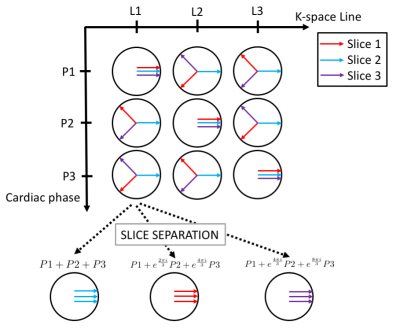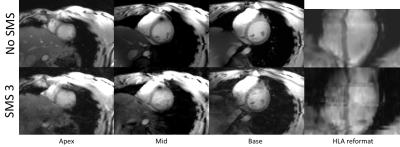1056
Simultaneous Multi-Slice (SMS) Cardiac CINE using embedded Hadamard-encoded reference data at 7 Teslastanislas Rapacchi1, Thomas Troalen2, Maxime Guye3, Monique Bernard3, Alexis Jacquier3, and Frank Kober3
1CRMBM, Aix Marseille University CNRS, Marseille, France, 2Siemens Healthineers, Saint Denis, France, 3Aix-Marseille Univ, CNRS, CRMBM, Marseille, France
Synopsis
To perform high-resolution cardiac function MRI, thin-slice Cine MRI at 7T is accelerated using Simultaneous Multi-Slice (SMS) technique. Additionally, Hadamard encoding strategy along the temporal dimension is superimposed on the CAIPIRINHA phase shift. The Hadamard-decoded data serve as embedded reference for SMS image reconstruction. Additional in-plane L1-SPIRiT reconstruction allows for limited noise amplification. Results show excellent slice separation, satisfactory SNR and CNR for assessment of cardiac function. However, SAR restrictions impose a lower flip angle for SMS acquisitions that result in poorer blood-to-myocardium contrast.
Introduction
High resolution is one of the major benefits expected from 7 Tesla Cardiac MRI exams, notably high-resolution cardiac dynamic MRI (Cine). However, increasing the resolution of Cine MRI is inherently limited by the duration of a breath-hold. Moreover, 2D Cine MRI resolution is highly anisotropic, with small pixels but thick slices. Therefore, Cine MRI could benefit from higher SNR at 7T to acquire thinner slices and thus improve partial volume issues within short-axis views. Within these considerations, the problem of limited breath-hold duration is shifted to the increased number of repeated breath-hold to cover the left ventricle (LV) with thinner slices. In this work, we propose to accelerate Cine MRI at 7T using Simultaneous Multi-Slice (SMS) technique(1). Additionally, a novel cardiac-dedicated SMS technique is proposed to alleviate the issue of alignment between single-band reference data and multi-band accelerated imaging data.Material and Methods
Acquisitions were performed on a 7T MRI scanner (Siemens Magnetom) using a 32Rx/8Tx cardiac coil (MRITOOLS). The 8Tx channels were combined as a single Tx channel using an optimized predefined phase set. Eight healthy volunteers were recruited after written consent was obtained. A 2D FLASH-Cine sequence with retrospective EKG gating was modified with CAIPIRINHA-SMS excitations(2). Instead of a separate reference acquisition, a Hadamard(3) SMS phase-shift pattern is introduced along the cardiac phase dimension to allow for slice separation (Figure1). The resulting Hadamard-decoded k-spaces can then serve for calibration of SMS-reconstruction. Cine parameters were SMS3x–GRAPPA2x, 1.8x1.8x4mm3 resolution reconstructed to 0.9x0.9x4mm3, 28ms temporal resolution, ~10s breath-hold/slice. The same acquisitions were performed without SMS acceleration (noted SS) for comparison. For both acquisitions, flip angle were maximized to fit within SAR restrictions. Image reconstruction combining Split-Slice GRAPPA(SSG) and in-plane GRAPPA was implemented online using Gadgetron(4). A second reconstruction using SSG + L1-SPIRiT was performed retrospectively. SNR and CNR were measured between the septum and the LV blood pool.Results
Using 1ms 3-bands excitations, specific absorption rate (SAR) restrictions imposed the flip angle for SMS-3 CINE to be reduced by 37 ± 7% compared to single-band CINE, from 36-69 to 20-50 degrees. Signal-to-noise ratio (SNR) measured in the septum showed a decrease from single-slice (SS) acquisitions to SMS acquisition (SNR(SS)= 8.7 ± 3.6 vs SNR(SMS)=5.5 ± 3.7, p=0.08) although not significantly. The CNR between the LV blood pool and the septum was significantly decreased from CNR(SS)= 12.4 ± 6.7 for single-slice CINE to CNR(SMS)=5.5 ± 2.7 (p<0.001) for SMS3-CINE. Figure 2 shows the results from one volunteer of the 3 slices and the long axis reformat. The 3 slices are well separated and image contrast is sufficient for assessing cardiac function. Similarly, blood-myocardium CNR was reduced (3.1±1.3 vs 7.1±2.5, p<0.01) due to the SAR-limited SMS excitations when compared to single-slice excitations. The resliced Cine in long axis view highlight revealed few SMS slices that had poorer image quality. Exploiting the sparsity in the spatio-temporal domain, Split-Slice-GRAPPA(SSG) + L1-SPIRiT image reconstruction was able to mitigate the noise amplification from SMS acquisition. The SNR was improved by 38 ± 24% and the CNR was improved as well by 45 ± 25 %.Conclusion and discussion
Accelerated high resolution Cine using SMS offers multiple perspectives, from simply reducing the examination time to reaching higher resolution to refine imaging of subtle pathologies such as ventricular non-compaction. The novel SMS technique detailed here shows promises for rapid high-resolution Cine which could also benefit clinical field MRI. However, the reduced flip angle imposed by SAR to account for increased power of multi-bands excitations impacts the image noise and contrast.Acknowledgements
This work was performed by a laboratory member of France Life Imaging network (grant ANR-11-INBS-0006). This work was performed on the platform 7T-AMI, a French “Investissements d’Avenir” programme” (grant ANR-11-EQPX-0001).References
1. Barth M, Breuer F, Koopmans PJ, Norris DG, Poser BA. Simultaneous multislice (SMS) imaging techniques. Magn. Reson. Med. 2016;75:63–81. doi: 10.1002/mrm.25897. 2. Breuer FA, Blaimer M, Mueller MF, Seiberlich N, Heidemann RM, Griswold MA, Jakob PM. Controlled aliasing in volumetric parallel imaging (2D CAIPIRINHA). Magn. Reson. Med. 2006;55:549–556. doi: 10.1002/mrm.20787. 3. Souza SP, Szumowski J, Dumoulin CL, Plewes DP, Glover G. SIMA: simultaneous multislice acquisition of MR images by Hadamard-encoded excitation. J. Comput. Assist. Tomogr. 1988;12:1026–1030. 4. Hansen MS, Sørensen TS. Gadgetron: an open source framework for medical image reconstruction. Magn. Reson. Med. 2013;69:1768–1776. doi: 10.1002/mrm.24389.Figures

Proposed Hadamard multi-band radiofrequency
CAIPIRINHA phase shifts for SMS-3 for different k-space lines and different
cardiac phases. The slice separated dataset serves to calibrate SMS
reconstruction.

Example of a SMS3-GRAPPA2 FLASH-CINE acquisition in a
healthy volunteer. The 3 levels of the left ventricle (apex, mid and base) are
covered in a 10s breath-hold.

Constrained reconstruction using Split-Slice GRAPPA + L1-SPIRiT limits noise amplification due to the acceleration. However, the SPIRiT reconstruction imposes a signal loss far away from the surface coil.